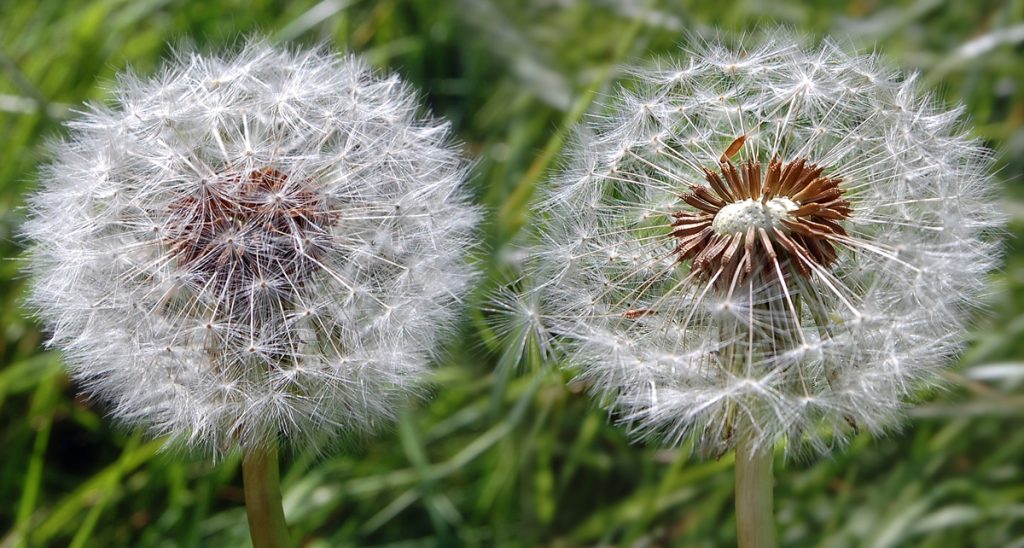I begin writing class by placing several objects on the front table: a red beaded bracelet, several small pieces of sky blue sea glass, and two seed-head dandelions that I picked just before class. I ask the students to approach the table, investigate the objects for several minutes, and then return to their desks to write a short reflection about what memories the objects bring about.
These writers are first-year college students who have moved to the United States to study art and design. Art students are a special breed. They seem hard-wired to ponder and explore. Many long to break apart their worlds and reassemble the pieces to reflect a reality that seems more personal and therefore more true.
I watch one young man pick up the red beaded bracelet and inspect it closely, like it is an ancient artifact from a distant world. A young woman from Korea holds the sea glass in her closed hands and delicately shakes the pieces together, smiling at the sound.
I ask her: what does it sound like? Her face tweaks, her smile fades, her shoulders curl in.
In addition to their drawing and design classes, these students are also trying to master the English language. Their fear of speaking aloud can be paralyzing. When I reflect on them trying to talk in front of the class, I picture them frantically trying to pull words from the electric air of their young minds and arrange them in an order that can express their deepest thoughts.
The student with the sea glass gasps. Her eyes open wide. The chosen words pour out: It sounds like edges of air.
She immediately frowns. This is not what she meant to say. I, however, find myself reveling in her response. The way these students scramble the language and rearrange it in new ways delights me. Words that are familiar to me—humdrum even—are cast in a new light. Listening to the students and how they explain their worlds pulls me closer to the moment.
I hold her gaze so she can register my fascination. Then I nod knowingly, smile, and walk away. I try to reassure them: something about their efforts is deeply good. They are willing to try, and this makes them brave.
They peer at the seed-headed dandelions from afar, but no one touches them. Later, we discuss why.
In my country the seeds represent wishes, one students says. You cannot touch unclaimed wishes.
Another student chimes in. They represent wishes in his country, too. Between them, an unexpected bridge forms.
What is the English word for that flower? another student asks.
I cast the question back out to the class. Does anyone know?
They stare at me. I wonder what they’re thinking. I treasure these moments of silence. They are brimming with doubt, hesitation, and curiosity. When I first started teaching, these long stretches of silence were intimidating. With practice, I’ve learned that the classroom can be a space where these students learn to hold uncertainty just as comfortably as they hold their pencils and sketchbooks.
I soon realize that no one knows the word. I turn around and write it on the board in large, lowercase letters:
d a n d e l i o n
Dun-duh-leeon! one student yelps.
DAN-dee-lion, I say, emphasizing the stress on the first syllable. The students giggle and echo: Dandy! Dandy! They are thrilled, and I find myself grinning. In this moment, we are ageless.
Later, I read their short reflections about their memories. I notice that many avoid writing in the past tense. I ask them why.
It’s too hard, one student admits. Can we just say present?
He means, can we just write in the present tense? It feels irresponsible to encourage him to dwell in the past when the present is more available.
I repeat the prompt to the class, and then ask them: what verb tense do you think is the most appropriate to use when writing about memories?
The steady silence consumes us once again. The students look past me. I watch them fish for words. One student meets my gaze. His eyes are golden and wide.
Present tense.
I let the urge to say No! Past tense! arise like a searing flame within me, burn wildly for a moment, and then settle.
Present tense. Can you explain why?
Yes, he says, with conviction. My experience of memory is in the present moment.
I absorb this comment and nod. The other students wait. Or maybe they ponder. I’m not sure. I let myself not know, and we move on.
Later, during a break, I wonder: Should I have insisted on the past tense? Or was I right to encourage them to write in whatever tense facilitates their moving closer to themselves, nearer to their own hearts?
Class ends. A student asks me if she can take a dandy-lion home. After I say yes, she smiles and skips away, cradling the seed-head in her curled hand.
[This story was first published in 2016.]
Thank you for subscribing to Tricycle! As a nonprofit, we depend on readers like you to keep Buddhist teachings and practices widely available.
